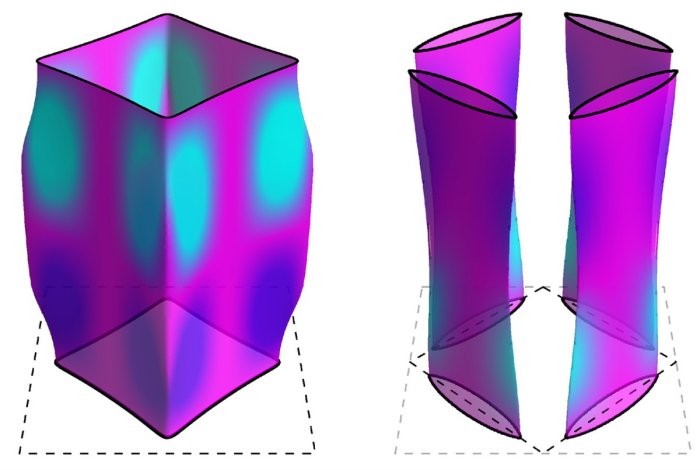Eddie Gonzales Jr. – MessageToEagle.com – Superconductors – metals in which electricity flows without resistance – hold promise as the defining material of the near future, according to physicist Brad Ramshaw, and are already used in medical imaging machines, drug discovery research, and quantum computers being built by Google and IBM.
However, the super-low temperatures conventional superconductors need to function – a few degrees above absolute zero – make them too expensive for wide use.
The Fermi surface on the left shows the arrangement of electrons in a copper-oxide high temperature superconductor before the “critical point.” After the critical point, the Fermi surface on the right shows that most electrons vanish. Research by the Brad Ramshaw’s lab connects this disappearance with magnetism.
In their quest to find more useful superconductors, Ramshaw, the Dick & Dale Reis Johnson Assistant Professor of physics in the College of Arts and Sciences (A&S), and colleagues have discovered that magnetism is key to understanding the behavior of electrons in “high-temperature” superconductors. With this finding, they’ve solved a 30-year-old mystery surrounding this class of superconductors, which function at much higher temperatures, greater than 100 degrees above absolute zero.
“We’d like to understand what makes these high-temperature superconductors work and engineer that property into some other material that is easier to adopt in technologies,” Ramshaw said.
A central mystery to high-temperature superconductors is what happens with their electrons, Ramshaw said.
“All metals have electrons, and when a metal becomes a superconductor, the electrons pair up with each other,” he said. “We measure something called the ‘Fermi surface,’ which you can think of as a map showing where all the electrons are in a metal.”
To study how electrons pair up in high-temperature superconductors, researchers continuously change the number of electrons through a process known as chemical doping. In high-temperature superconductors, at a certain “critical point,” electrons seem to vanish from the Fermi surface map, Ramshaw said.
The researchers zeroed in on this critical point to figure out what makes the electrons vanish, and where they go. They used the strongest steady-state magnet in the world, the 45-tesla hybrid magnet at the National High Magnetic Field Laboratory in Tallahassee, Florida, to measure the Fermi surface of a copper-oxide high temperature superconductor as a function of electron concentration, right around the critical point.
They found that the Fermi surface changes completely as researchers dial past the critical point.
“It’s as if you were looking at a real map and all of a sudden most of the continents just disappeared,” Ramshaw said. “That’s what we found happens to the Fermi surface of high-temperature superconductors at the critical point – most of the electrons in a particular region, a particular part of the map, vanish.”
It was important for the researchers to note not just that electrons were vanishing, but which ones in particular, Ramshaw said.
They built different simulation models based on several theories and tested whether they could explain the data, said Yawen Fang, doctoral student in physics and lead author of the paper.
“In the end, we have a winning model, which is the one associated with magnetism,” Fang said. “We are stepping confidently from the well-understood side of the material, benchmarking our technique, into the mysterious side past the critical point.”
Now that they know which electrons vanish, the researchers have an idea why – it has to do with magnetism.
“There have always been hints that magnetism and superconductivity are related in high-temperature superconductors, and our work shows that this magnetism seems to appear right at the critical point and gobble up most of the electrons,” Ramshaw said.
“This critical point also marks the electron concentration where the superconductivity happens at the highest temperatures, and higher-temperature superconductors are the goal here.”
Knowing that the critical point is associated with magnetism offers insight into why these particular superconductors have such high transition temperatures, Ramshaw said, and maybe even where to look to find new ones with even higher transition temperatures.
“It is a 30-year-old debate that precedes our study, and we came up with a straightforward answer,” said Gaël Grissonnanche, a postdoctoral fellow with the Kavli Institute at Cornell for Nanoscale Science and co-first author.
Written by Eddie Gonzales Jr. – MessageToEagle.com Staff







